It’s time to break out of Bangkok and head North to see UNESCO World Heritage sites, visit hill tribe villages, taste a wide variety of local specialties, and of course, go shopping. Tonight we’ll be staying in the hot and humid central plain, where temple etiquette demanding long pants promises to make ice water one of my favorite foods.
I awoke involuntarily at 3:00am, but this allowed just enough time to pack and check out, so my unconscious mind knows better than me. The sun was just coloring the sky when we stopped at a gas station to visit their coffee shop. A bit further up the highway, we stopped to buy shrimp paste, an essential ingredient in many curries. Shrimp paste is made from tiny shrimp laid out in the sun to dry and then packed with salt until well fermented and the mixture looks somewhat purple from the pigments of the shrimp eyeballs. As we were in a hurry, we didn’t sniff or sample the paste, which is just as well since we were about to embark on several hours of eating.
The Floating Market
Damnoen Saduak is the home of the most famous and touristed of the floating markets near Bangkok. Since my last visit in 2010, it seems that an even larger proportion of the canals are occupied by wall-to-wall souvenir shops, and noisy diesel engine boats have become more prevalent, driven mostly by young men who appear to have eschewed the difficult work of providing locomotion with a paddle.
Slipping into the water at about 7:30am, the market was fairly quiet but it was only moments before we scored some coconut pancakes. Cooked on a griddle on a smiling vendor’s boat, the sweet pancakes feature shreds of coconut and leave oil on your fingers. Not health food, but a fun way to start the morning. Our next treats were fried banana slices and fried sweet potato batons in a light batter with sesame seeds. I’m a sucker for anything with sesame seeds, even if it happens to be very energy dense. At one point we got a tray of lightly sweet but slightly dry pomelo segments. I recently read that grapefuits were created by crossing pomelos with oranges; you certainly can see that from their respective sizes.
The old obscure location where we saw the nectar of the flowers of the coconut palm being boiled down to palm sugar has closed, but a huge “Coconut Sugar Farm” offers a peek at various steps in the process, including tasting the lightly sweet liquid nectar fresh from the blossoms, seeing bees dive into the hot syrup (they do not fly out), sipping the partially thickened syrup over ice, munching on crumbly bits of the dried sugar, and crunching through peanut candy set in coconut sugar caramel. Of course some purchases were necessary, but we managed to avoid all the touristy toys and gimmicks throughout the rest of the shop. The Farm was preparing for a ceremony later in the day, so numerous delicious looking plates of whole fish, roast pork and other festive dishes were laid out in various states of preparation — seemingly for our photographing pleasure.
We returned to the dock, pausing to negotiate prices for bowls carved from mango wood. We will see more mango wood in Chiang Mai, so I’ll consider potential purchases then. At the dock we assembled on tiny stools perilously close to the water’s edge for bowls of “boat noodles.” A deeply flavored broth is poured over fish sauce, peanuts, thin slices of several kinds of pork (including pork liver), aromatics, thin stretchy rice noodles, and bean sprouts. A lot of chillies also were added; this soup was hot. Fortunately our side dishes were mild: rambutans, sweet khanom krok, and mango with sweet sticky rice. Very filling, but we’ll need to work it off so we can eat again in another two hours.
There was a little time for shopping, and I prowled around looking for very lightweight shirts. The first one was a definite rip-off, which of course is my own fault for not walking away. The second and third ones were merely overpriced as befits a tourist trap. Anyway, I have more local shirts and can stop looking so Hawaiian.

View the entire album: Damnoen Saduak Floating Market – Thailand Photos 2013
Nakhon Pathom
The temple here has a huge chedi (stupa) atop a tall staircase. Ringing the chedi are innumerable Buddha images in a seemingly endless range of named poses. But equally important in Kasma’s decision to stop here were the different kinds of sticky rice snacks available from the town’s street vendors. From the market at the bottom of the temple, we picked up coconut sticky rice cooked in bananas leaves rendered brown and tattered by a charcoal fire. Sweetened with palm sugar, the rice had a sticky, chewy texture.
Around the corner we saw a man frying what looked like doughnuts, but which turned out to be discs of sweetened sticky rice. After these drained on a rack, he used scissors to cut off pieces directly in a huge bowl of sugar with black sesame seeds. You get them in a plastic bag with a pair of sticks for spearing and eating the sweet, chewy pieces. Although I couldn’t tell much difference between the plain sticky rice discs and the ones with taro mixed in, both were a decadent treat.
On the way to our restaurant, we stopped in front of an old woman with a large cleaver and pile of fat 18 inch bamboo poles. Inside we would discover that these contained sticky rice with black beans, somewhat less gooey than the other two snacks.
At the noodle shop, we were no longer voraciously hungry, but we could not skip the opportunity to have a few appetizers. These were skewers of chicken satay with peanut sauce and cucumber salad, and delightfully light and fluffy fish cakes loaded with bits of green bean and accompanied by a sweet spicy dipping sauce. And then came the duck noodle soup. The flavorful broth was the star, and a little extra heat didn’t hurt. I accidentally abandoned our leftover “doughnut” pieces at the restaurant, and will have to find a way to make it up to anyone who was hoping for one more piece.

View the entire album: Street Snacks in Nakhon Pathom – Thailand Photos 2013
Ayutthaya
Before Bangkok was established as the capital of the Thai kingdom, the royal court was located in Ayutthaya, named for the invincible city in the Ramakien legend. It is perhaps not a coincidence that neither city turned out to be invincible after all, and the real life Ayutthaya was sacked by Burma and left in ruins. The ruins are a UNESCO World Heritage site, so we can’t miss the opportunity to see what remains of the glory of the Venice of the East.
After a drive of several hours up the highway, we stopped first at Wat Chai Wattanaram, an ancient site that is temporarily closed for conservation work after this past Spring’s flooding created concern about the foundations of the various brick structures. Although some of the drama of the temple is not apparent from the external viewing area, we did get a few long distance photos, and we enjoyed a refreshing young coconut, so that was some consolation. Photos from my 2008 trip can be found here: On and Off the Island.
Since it was a bit early to check in, we visited two more temples. Wat Lokayasutha is known for a large reclining Buddha, and the late afternoon light was more flattering than the late-morning light under which I had previously seen it. The rest of the temple complex appears to be quite thoroughly ruined. Wat Na Phramane, on the other hand, is a more modern temple. Its main claim to fame would be housing a 1500-year-old stone Buddha with a serene expression.
[PHOTOS COMING]
Ayothaya Hotel
Not much to report. Excellent air conditioning. Weirdly non-absorbent towels (too much fabric softener?).
Dinner at Pae Krung Kao
One of the most popular restaurants in town, Pae Krung Kao is situated on a river with a wide open view of immense barges being towed by. The star of the show, however, were the enormous river prawns. Split lengthwise, each half-tail was a generous portion of lobster-like meatiness, with a dab of red curry liver sauce available for flavor, and various shelly parts available for the picking. Not that we lacked for variety — or volume. A bowl of hot and sour seafood soup, a green curry with fish dumplings, and Chinese broccoli with salted fish provided delicious accompaniments. Then we got an enormous pork leg that had been simmered for hours in spices then deep fried to a crisp. Somehow thick pads of succulent pork fat survived all the cooking, balancing the crispy texture of the skin and the chewier texture of the tender meat. If you’re eventually going to have to go on a cardiac diet, this is the dish you want to look fondly back on as having enjoyed one too many times. Last but not least, we got a larb made from the meat of a snake head fish. To cleanse our palate we had crisp, juicy, mildly sweet slices of rose apple, and leftover sticky rice treats from lunch. This one had a big plug of tasty coconut milk custard at one end. Mixed with the bland sticky rice and black bean end, it was a nicely balanced bite.
It has been observed that I am eating more on this trip than on past trips. I don’t see how that’s possible, but I’m definitely doing my “once a week” overeating at every meal now, so it won’t last. I intentionally brought pants that are a half-size too tight to restrain myself. I sincerely hope I won’t need to visit a tailor in the next town. (Which, by the way, is Sukhothai.)
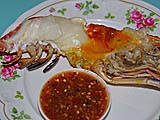
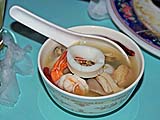
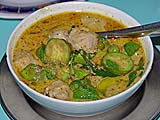

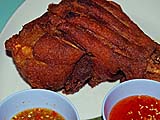

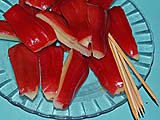
Sorry, the comment form is closed at this time.